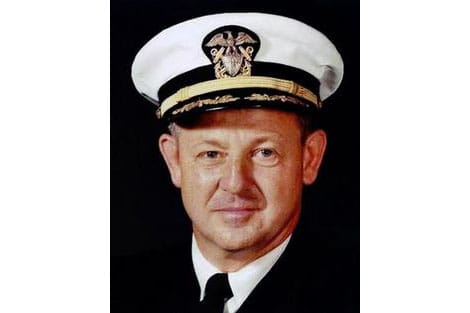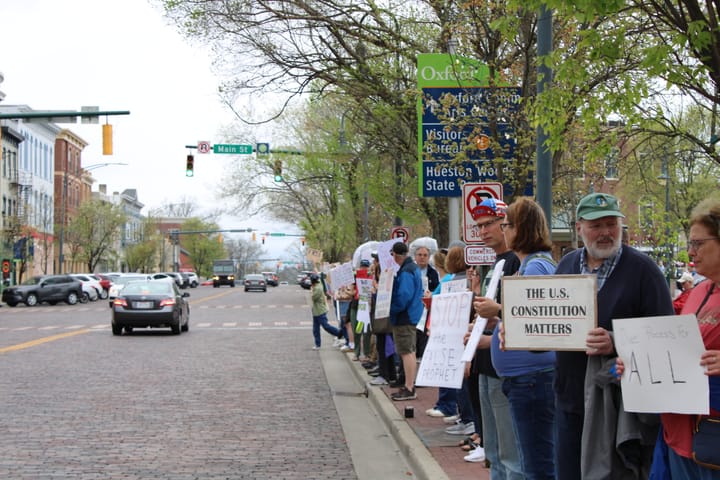Local Legends: A proud vet
Kenneth M. Glass had a decorated career as an aviator in the U.S. Navy, traveling across the Pacific Ocean during World War II. After returning home, he finished college in Detroit and started a 25-year career at Miami University in Oxford.

In commemoration of Veterans Day, few stories are more appropriate to share than that of Captain Kenneth M. Glass, a proud veteran who made his home in Oxford after a long and distinguished naval and academic career.
Glass was born in Dundee, Iowa, a rural agricultural community, on Feb. 22, 1922. The son of Rupert and Weltha (Boyd) Glass, he toiled on the family farm throughout his childhood.
However, Glass didn’t want to make farming his career, and he began working towards a college degree at Upper Iowa University in 1939. He was sitting with his family at home when he heard the radio broadcasts announcing the Pearl Harbor Attack on Dec. 7, 1941.
Leaving the university, Glass enlisted in the U.S. Navy at Wold-Chamberlain Field, now Minneapolis-Saint Paul International Airport, on June 4, 1942. That same day, the tide of the fighting in the Pacific Theater turned after the United States claimed victory in the Battle of Midway, the first naval battle fought solely with aircraft in world history.
Glass aspired to be a Naval Aviator. After entering that training program, he was sent from Naval Reserve Aviation Base Minneapolis, Minnesota to Naval Air Station Corpus Christi, Texas. As an aviation cadet, Glass learned how to fly and earned his wings of gold on Jan. 1, 1943.
Qualified as a pilot for the Grumman TBF Avenger Torpedo Bomber, Glass was first stationed at Quonset Point, Rhode Island, starting in June 1943. His unit, Torpedo Squadron 2 (VT-2), left for Hawaii aboard the U.S.S. Cabot (CVL-28) on Nov. 20, 1943.
After arriving in Hawaii, the squadron conducted further training before being assigned to the U.S.S. Hornet (CV-12). Laid down Aug. 3, 1942 and launched Aug. 30, 1943, the Hornet was named in honor of the U.S.S. Hornet (CV-8), the carrier that had conducted the Doolittle Raid against Tokyo early in the war and had recently been sunk in the Battle of the Santa Cruz Islands.
Glass flew his aircraft onto the Hornet for the first time in March 1944 and would see heavy combat before departing the ship. He and his fellow air crews initially provided air support for General McArthur’s ground forces in the Western New Guinea Campaign.
They then went on to conduct a series of air raids against Japanese military installations, targeting the Caroline Islands, Saipan, Tinian, Iwo Jima, Chichi Jima and Rota. Glass was forced to ditch his Avenger in the ocean on take off en route to a raid on the Palau Islands and was recovered by the U.S.S. Monaghan (DD-354).
Hornet took part in the Battle of the Philippine Sea, known to history as “The Great Marianas Turkey Shoot.” The day following the attack, Glass took off in pursuit of the now retreating enemy ships. VT-2 found and engaged some of the retreating vessels, described in their unit’s cruise book as “an unforgettable day in naval aviation … no one will forget the hectic trip home and the landings that night!”
The Hornet’s squadrons continued their air raids, striking several additional targets across the Pacific, including the major Japanese base at Truk. Glass’ last six missions were flown in support of the invasion of the Philippines and he arrived back in the States on Nov. 1, 1944.
However, Glass’ service wasn’t yet over. He did a second tour in the Pacific at Barbers Point, Hawaii from June 1945 to March 1946, serving as the executive officer for a unit of replacement carrier pilots.
After returning to the U.S., Glass considered making a career out of the Navy but ultimately decided against it and was discharged on Jun. 14, 1946. He later served in the Navy Reserve for several years, . Returning to Iowa, he married Dorris Emalene (Vickers) Glass the following month.
Glass worked in the soil conservation industry before finishing college in Detroit at Wayne State University. His first marriage had ended, and while in Detroit he met and married Rose (Pytroczko) Glass.
Having completed his undergraduate and masters programs, Glass went on to become a Doctor of Education. In 1963, he and his family moved to Oxford, where Glass was employed by Miami University. He retired from Miami as an associate dean of education at the end of a 25-year career. A proud Miami family, all five of Glass’ sons graduated from the school, and he and his wife were named Miami Parents of the Year in 1985.
Glass often spoke to groups and classes about his World War II experiences, working to ensure that the Hornet’s sailors were not forgotten to history. He served as president of the U.S.S. Hornet Club, was named to the Ohio Veterans Hall of Fame as part of the Class of 1996, and wrote a book “The Hornets and Their Heroic Men” in 1998.
Glass died on Oct. 21, 2017. Rose Glass died two months later on Dec. 15, 2017. They are buried in the Miami University section at Oxford Cemetery.
Brad Spurlock is the manager of the Smith Library of Regional History and Cummins Local History Room, Lane Libraries. A certified archivist, Brad has over a decade of experience working with local history, maintaining archival collections and collaborating on community history projects.




